What Is The State Animal Of Washington
Symbols are often adopted after a concerted attempt by citizens to take a pregnant item recognized for its importance to the state. To that end, citizens, organizations or school children oftentimes research a particular symbol and make a request for a nib. They track the bill through the Legislative process (see "How a Nib Becomes a Law"), ofttimes providing further information about their request to the Legislature.
If canonical by the Legislature, the bill is enacted and there is a new country symbol. Information about the country symbols can be found in Chapter 1.20 RCW, General Provisions. The symbols are listed below in the guild they were adopted by the Legislature. (Click hither to access a Print Version.)
Seal | Flower| Flag | Tree | Bird| Song | Fish | Gem | Dance| Folk Song | Fruit | Grass
| Tartan| Insect | Fossil | Marine Mammal | Vegetable | Amphibian | Ship | Owned Mammal
Oyster | Waterfall
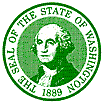 Land Seal
Land Seal
In 1889, jeweler Charles Talcott designed our beginning state seal using an ink bottle, silver dollar and a postage stamp postage stamp. Talcott's blood brother, L. Grant Talcott, lettered the words, "The Seal of the State of Washington, 1889," and some other blood brother, G.N. Talcott, cutting the printing die. More information can exist found at the Secretarial assistant of State site on the Country Seal .
 Country Flower
Country Flower
Coast Rhododendron
In 1892, earlier they had the right to vote, Washington women selected the coast rhododendron equally the state flower. They wanted an official flower to enter in a floral showroom at the 1893 Earth'southward Fair in Chicago. Six flowers were considered, merely the terminal decision was narrowed to clover and the "rhodie," and voting booths were set upward for ladies throughout the state. When the ballots were counted, the rhododendron had been chosen as the Washington state bloom. In 1959, the Legislature designated the native species, Rhododendron macrophyllum, equally the official bloom of the land of Washington.
 The State Flag
The State Flag
The country flag and the state seal are similar. Passed in 1923, Washington law describes the flag as having nighttime green bunting with a land seal in the center. In the late 1890s, a bluish and golden military machine land flag with George Washington'south profile on it flew over many cities and towns throughout the state. Just when information technology came to a concluding decision, the current flag was adopted by the Legislature. According to police force, the flag of the Usa and the flag of the land shall be prominently installed, displayed and maintained in schools, court rooms and land buildings. For farther data most the state flag, check the Secretarial assistant of Land'due south web site.
 Land Tree
Land Tree
Western Hemlock
In 1946, an Oregon newspaper teased Washington for not having a state tree. The Portland Oregonian picked out the western hemlock, Tsuga heterophylla for us, simply Washington newspapers decided to choose their own and selected the popular western cerise cedar. State Representative George Adams of Mason Canton pleaded with the Legislature to prefer the western hemlock. The hemlock, he said, would become "the backbone of this land'south wood industry." Adams' bill passed the Legislature and was signed into constabulary in 1947.
 State Bird
State Bird
Willow Goldfinch
The goldfinch is a delicate petty bird with a yellow body and black wings, and although it eventually became the official land bird, many other birds were considered for the title. In 1928, legislators allow school children select the state bird and the meadowlark won hands-down. It was a prissy choice but vii other states already had chosen the aforementioned bird. Some other vote was taken in 1931 by the Washington Federation of Women'due south Clubs. Many birds were nominated, just the goldfinch won handily over the tanager, song sparrow, junco and pileated woodpecker. Now there were two state birds and the Legislature decided to leave the terminal pick to school children. In 1951, children voted for the goldfinch and the Legislature fabricated it unanimous.
 State Song
State Song
"Washington, My Dwelling house"
The state song, "Washington, My Home," was written past Helen Davis, arranged past Stuart Churchill, and became the official state vocal in 1959. Simply, like the goldfinch, it had some stiff competition from another pop song. Back in 1909, "Washington Beloved" was adopted, sort of, by the Legislature. Professor Edmond Meany, the historian, wrote the words and Reginald de Koven, who also wrote "O Promise Me" and other operettas, wrote the music. But the official designation for the song was never formally introduced every bit a bill and so was non part of the land's lawmaking of law. When a state senator from South Bend introduced a bill in 1959 to brand "Washington, My Home" our land song, information technology was approved unanimously.
In April, 2002, the country vocal was performed at the land Capitol past the Tumwater Girls' Choir, under the management of Jack Arend, choir manager.
Download the sheet music here: Washington My Home
This recording is provided courtesy of TVW in 2 formats: ![]() mp3
mp3 ![]() WAV
WAV
 State Fish
State Fish
Steelhead Trout
The steelhead trout is an anadromous fish, pregnant it returns to fresh h2o rivers to spawn. The scales of the steelhead polish flecks of silver with a gray spotted back from caput to tail and an intensely white abdomen; the two colors separated by a hint of opalescent pink. Steelhead trout is one of the about popular fish for recreational fishing, a major industry in Washington State. The steelhead trout ( Oncorhynchus mykiss irideus ) was adopted by the Legislature as a state symbol in 1969.
 State Gem
State Gem
Petrified Woods
The geological history of our state has encompassed many dandy changes, one of them being the many lava flows from volcanic fissures. Centuries ago, the interior of Washington was swampy and mild with many copse such as cypress, oak, elm and gingko growing in wet areas. Layers of logs were preserved with each new lava flow, and as the layers grew deeper, many of the logs became waterlogged and lay protected in deep water. Over time, water continued to seep through the lava and permeate the woods with silica. Somewhen, the woods cobweb was completely replaced by silica, thus petrifying many logs. The petrified woods is perfect in class and detail to the original wood. In 1975, petrified forest was adopted as the country gem. The best identify to come across petrified forest is the Gingko Petrified Forest State Park in Vantage.
 State Trip the light fantastic toe
State Trip the light fantastic toe
Foursquare Dance
On April 17, 1979, the square dance became the official Washington state dance. When the pioneers came due west, they brought with them a dance called the quadrille, which means square in French. The pioneers liked the simpler term then the square trip the light fantastic toe was built-in. The dance is known for its series of figures and footwork. Dancers are directed by a caller. It is easy to larn, a good class of exercise, and fun.
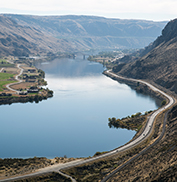 State Folk Song
State Folk Song
"Roll On, Columbia, Roll On"
In the early 1940s, the federal Bonneville Power Administration produced a picture encouraging rural residents in the Pacific Northwest to electrify their homes and farms with the power being generated by the newly-built Bonneville and Thou Coulee Dams on the Columbia River. As part of the project, BPA hired folksinger Woody Guthrie at $270 for 30 days to write songs for the picture show. Guthrie wrote 26 songs, the most pop of which was "Ringlet On, Columbia, Ringlet On," an ode to the harnessing of Washington's mightiest river. Information technology was canonical equally the official Washington state folk song by the Legislature in 1987.
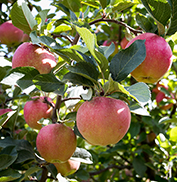 State Fruit
State Fruit
Apple
Washington is the nation's acme apple-producing state, so it is advisable that the apple tree was named a state symbol in 1989, the centennial year. A favorite fruit around the earth, the apple comes in many dissimilar colors, sizes and varieties. From the beautiful blossoms of spring, to the heavily laden branches in fall, the apple trees of eastern Washington stand for i of the largest industries in the state. The Washington apple is certainly one of the most recognized symbols of the state worldwide.
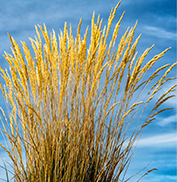 State Grass
State Grass
Bluebunch Wheatgrass
Although many state symbols are readily identifiable with the western part of the state, bluebunch wheatgrass is a state symbol that is unique to eastern Washington. Bluebunch wheatgrass was a approval to Washington'south pioneer farmers and continues to play a major role in our agriculture industry today. It was adopted past the 1989 Legislature as the official state grass. Its botanical proper noun is Pseudoroegneria spicata .
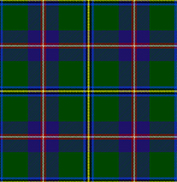 State Tartan
State Tartan
A tartan is a design for the weaving of cloth consisting of perpendicular bands of contrasting colors on a solid background. The Washington State tartan was designed in 1988 by Vancouver, U.s. Country Dancers Margaret McLeod van Nus and Frank Cannonita to commemorate the Washington Country Centennial celebration. Information technology is identified by the background color greenish, which represents the rich forests of Washington, the "Evergreen Country." The perpendicular bands of contrasting colors represent the following features: blue for the lakes, rivers and ocean; white for the snowfall-capped mountains; ruby for the apple tree and cerise crops; yellowish for the wheat and grain crops; and black for the eruption of Mount St. Helens. The neb, designating a state tartan, was signed into law in 1991. The Council of the Scottish Tartans Society also affixed its seal to the official Certificate of Accreditation in 1991.
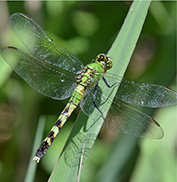 State Insect
State Insect
Light-green Darner Dragonfly
In 1997, the mutual light-green darner dragonfly, Anax junius Drury, became Washington'due south official state insect after a grouping of students at Crestwood Uncomplicated School in Kent brought the idea to the Legislature. Students from over 100 school districts statewide participated in the choice of the common green darner dragonfly. Likewise known as the "mosquito hawk," this insect tin be constitute throughout Washington and is a benign contributor to the ecosystem because it consumes a big number of insect pests. It is easily recognizable by its bright green head and thorax, it has a four to half dozen-inch wingspan and can fly 25 to 35 miles per hour. In that location are over 400 different species of dragonflies. Dragonflies existed prior to the dinosaur age and some had upward to a three-human foot wing bridge. "Darner" is 1 family of dragonflies and the common green (Anax junius) was first sighted and recorded past Drury in 1773.
 State Fossil
State Fossil
Columbian Mammoth
Following a 4-yr effort by students from Windsor Uncomplicated School near Cheney to have this behemoth designated as our state fossil, the Legislature recognized in 1998 that the large, hairy prehistoric elephants of the extinct genus Mammuthus roamed the Due north American continent, including the Pacific Northwest, during the Pleistocene epoch (ice ages). Mammoth is the mutual name given to any fellow member of an extinct genus Mammuthus of the elephant family. The starting time North American mammoths migrated across the Bering Strait from Asia down through Alaska almost two meg years ago. Nearly all mammoths died out about 10,000 years ago. From studies based on deposits of the Columbian mammoths, M. columbi, information technology is clear that grasses featured prominently in their diets. The maximum life expectancy of the mammoth would have been threescore to 65 years. The males grew to the size of modern adult elephants; females were about one-half that size. Several years ago, fossils of the Columbian mammoth were establish on the Olympic Peninsula.
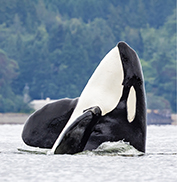 Land Marine Mammal
Land Marine Mammal
Orca
As a issue of ii years of research and persuasion past 2d graders from the Crescent Harbor Elementary School in Oak Harbor, the Legislature designated the orca, Orcinus orca, as the official marine mammal of the country of Washington in 2005. Many people visit Washington state to watch orcas; the orca is a significant symbol for the Native American culture; there are pods of orcas that migrate annually through Puget Sound; and the orca is easily recognizable considering of its distinct markings. The designation is intended to promote orca awareness and to encourage protection of the natural marine habitat.
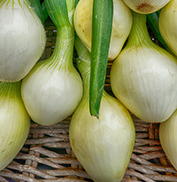 State Vegetable
State Vegetable
Walla Walla sweet onion
In 2007, the Walla Walla sweet onion was designated as the official vegetable of the country of Washington.
The Walla Walla Sweet is from Walla Walla and is only grown properly in the Walla Walla Valley. The Walla Walla Sweet finds its origins on the isle of Corsica. Over a century agone, a retired French soldier plant a sweet onion seed there and brought it to the Walla Walla Valley. The sweet onion had impressive winter hardiness well-suited for the climate of southeastern Washington. Before long he and other immigrants in the area began harvesting the seed. After several generations of careful hand selection, the sweetness onion adult greater sugariness, size, and shape. Today, at that place are many growers producing Walla Walla Sweet onions on farmland in the Walla Walla Valley. Sweetness onion flavour is mid-June through September.
The measure was a class project for a seventh-grade honors social-studies class at Eatonville Centre School. In prior years, the nib had also been a project of a Kirkland Inferior loftier school.
Country Amphibian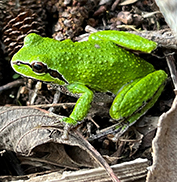
Pseudacris regilla
In 2007, the Pacific chorus frog was designated as the official amphibian of the State of Washington.
Because Pacific chorus frogs live in every county in the state and on both sides of the Cascades, they are an first-class pick as an keepsake for the whole state. The Pacific chorus frog is charming and makes beautiful sounds. Less than ii inches long, they swell their throat sacs to three times the size of their heads to transport their calls into the dark. This amphibian is useful because it eats insects, including mosquitoes. Information technology is recognizable by the black stripe through the eye to the shoulder, and can be brown, tan, grey or greenish. A native amphibian, it is preyed upon past bullfrogs, snakes, raccoons, shorebirds, hawks and ducks.
A third grade course at Boston Harbor Grade School in north Olympia, demonstrated excellent knowledge about the political process in making this proposal to the Legislature as the projection involved science, research, art, and persuasive writing.
State Transport
Lady Washington
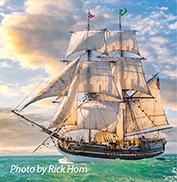 The legislature designated the Lady Washington as the official transport of the state of Washington in 2007.
The legislature designated the Lady Washington as the official transport of the state of Washington in 2007.
Congenital over a two-year menses and launched on March 7, 1989, the transport was built in Aberdeen by the Grays Harbor Historical Seaport Authority. Master shipwrights from all over the Pacific Northwest constructed her near the confluence of the Wishkah and Chehalis rivers. The Lady Washington is based in Aberdeen.
A reproduction sailing transport of the original Washington/Lady Washington that sailed during approximately 1750-1798, the vessel blazon is a "brig," indicating the configuration of the sails.
The Part of the Secretary of Land for the state of Washington holds a mortgage on the vessel to secure the investment of the people of Washington.
(photo courtesy of Ron Arel)
State Endemic Mammal
Marmota olympus
 In 2009, the Olympic marmot, the only endemic mammal in Washington country, was designated as the land endemic mammal following a proposal from the 4th and 5th graders at Wedgwood School in Seattle. The Olympic Marmot inhabits the Olympic Peninsula in the western section of Washington. Olympic Marmots are highly social animals and may alive in groups of over a dozen animals. Gregarious bonds are made betwixt animals in a family. Olympic Marmots identify each other by touching noses and smelling cheeks. Olympic Marmots hibernate from September to May. During the morning time and afternoon on summer days, they feed and spend their time sunbathing on rocks. In the evening, they return to their burrows. Olympic Marmots are relatively easy to see during the summer months along Hurricane Ridge in the Olympic National Park.
In 2009, the Olympic marmot, the only endemic mammal in Washington country, was designated as the land endemic mammal following a proposal from the 4th and 5th graders at Wedgwood School in Seattle. The Olympic Marmot inhabits the Olympic Peninsula in the western section of Washington. Olympic Marmots are highly social animals and may alive in groups of over a dozen animals. Gregarious bonds are made betwixt animals in a family. Olympic Marmots identify each other by touching noses and smelling cheeks. Olympic Marmots hibernate from September to May. During the morning time and afternoon on summer days, they feed and spend their time sunbathing on rocks. In the evening, they return to their burrows. Olympic Marmots are relatively easy to see during the summer months along Hurricane Ridge in the Olympic National Park.
Country Oyster
Ostrea lurida
 The Ostrea lurida was designated the official oyster of the state of Washington. This native oyster species plays an important role in the history and culture that surrounds shellfish in Washington state and along the w declension of the Us. Some of the common tribal and other names used for this species are Native, Western, and Olympia.
The Ostrea lurida was designated the official oyster of the state of Washington. This native oyster species plays an important role in the history and culture that surrounds shellfish in Washington state and along the w declension of the Us. Some of the common tribal and other names used for this species are Native, Western, and Olympia.
The Ostrea lurida was designated as a land symbol in 2014.
State Waterfall --- Unofficial State Symbols ---
Palouse Falls
 The tourist industry is a vital office of the state's economy. Palouse Falls has visitors numbering averaging over eighty grand to i hundred thousand per twelvemonth. The falls drop one hundred ninety-eight feet identifying them every bit the final remaining year-round waterfalls left past the ice historic period floods.
The tourist industry is a vital office of the state's economy. Palouse Falls has visitors numbering averaging over eighty grand to i hundred thousand per twelvemonth. The falls drop one hundred ninety-eight feet identifying them every bit the final remaining year-round waterfalls left past the ice historic period floods.
Palouse Falls was named sixth on the height ten best United States waterfalls list, tenth on the list of the world's most astonishing waterfalls, and the site of the world tape breaking kayak drop.
Palouse Falls surrounding surface area is the location for the oldest documented remains found in the western hemisphere; home of the Palouse Native American culture; birthplace of the Appaloosa horse; and documented in Lewis and Clark'due south journals.
The Palouse Falls was designated equally a state symbol in 2014.
Some mottos and icons are understood to correspond our land, fifty-fifty though they have never been officially adopted past the legislature. 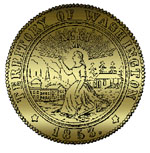 Territorial Motto
Territorial Motto
"Al-ki" or "Alki"
Al-ki or Alki is an Indian word meaning "bye and farewell." This motto showtime appeared on the territorial seal designed by Lt. J.Thou. Duncan of Gov. Stevens' surveying expedition. On one side it pictures a log cabin and an immigrant carriage with a fir forest in the background; on the other side, a sheet of water being traversed by a steamer and sailing vessel, a city in perspective; the Goddess of Hope and an anchor is in the centre. The figure points at the significant word "Alki." Settlers from the schooner Exact named their settlement on Alki Point, New York. The new settlement was slower to grow than its East Declension analogue, notwithstanding, so the name was changed to New York-Alki, meaning "into the future" -- the 1850s version of the term "bye and bye" or, "I will see y'all, farewell and bye."
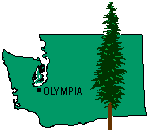 "The Evergreen State"
"The Evergreen State"
On November 11, 1889, Washington became the 42nd state to enter the Wedlock. It is the only land in the Matrimony that is named for a president. Washington was nicknamed "The Evergreen State" by C.T. Conover, pioneer Seattle realtor and historian, for its arable evergreen forests. The nickname has never been officially adopted. 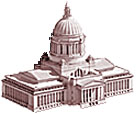 Country Capitol Building
Country Capitol Building
The present land capitol building in Olympia, Washington, was first occupied by the Legislature in March 1927. The design is reminiscent of the Acropolis in Athens, Hellenic republic. It is also closest in blueprint to the U.Southward. Capitol in Washington, D.C. Although non an official state symbol, the image of this architectural structure truly represents our state government and cute capitol urban center.
Source: http://leg.wa.gov/Symbols/Pages/default.aspx
Posted by: bowleytroses.blogspot.com

0 Response to "What Is The State Animal Of Washington"
Post a Comment